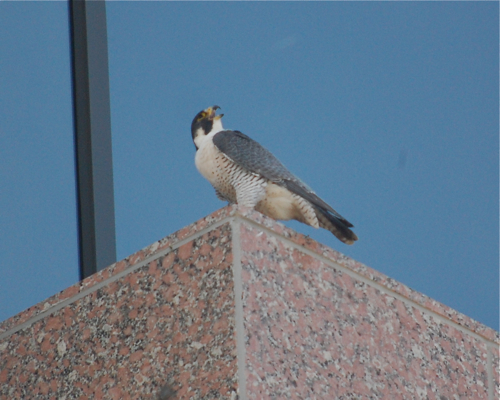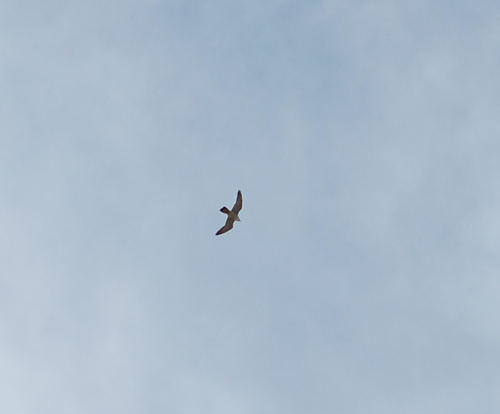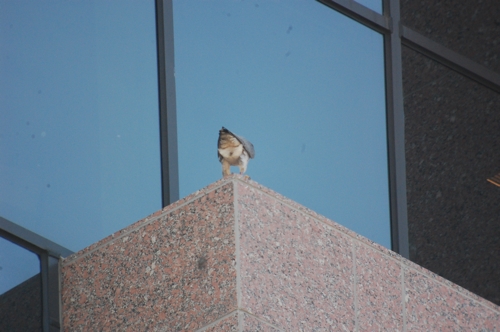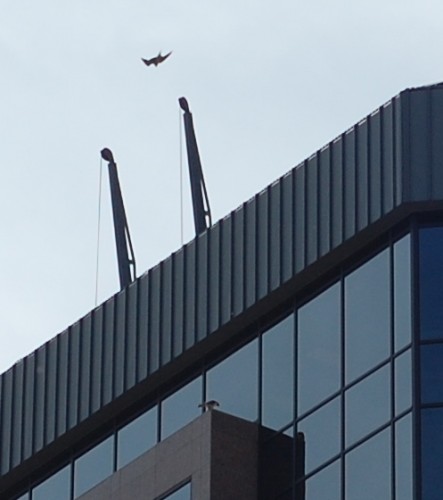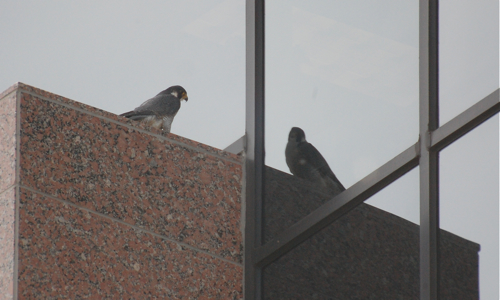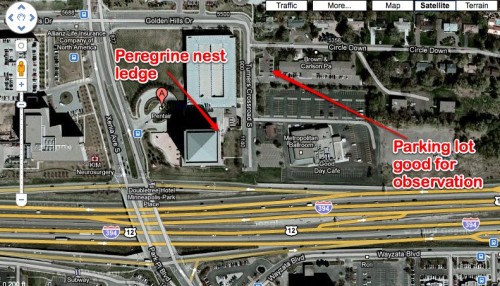I walked into my bedroom today to find a most unexpected sight:

A pigeon on my unmade bed! The unmade bed was not a surprise--but the bird sure was. It's spring so the windows are open in our apartment and I had a screen up near our bird feeders and I suspect that's where this dude came from. I left the window open and tried to scoot it towards the wild blue yonder. The pigeon had no desire to go. I even gave it a light toss and the bird responded by doing a U Turn and flew right back in to my bedroom. I even tried leaving a trail of seed out the window to encourage the bird to leave. It didn't work.

Based on the bird's reaction to me, I began to suspect that this was not a wild pigeon after all. I had an idea of where this bird came from. We have some neighbors who had a pigeon and I wondered if it was their bird. I walked over and asked if their pigeon was missing. They told me that they raised it and let it go and for some reason it keeps coming back. I mentioned that I had a pigeon in my bedroom and suspected it was their pigeon. They did not want it back, they were done with it. I had a choice at this moment: give them the lecture about about why you can't raise a bird indoors, release it and expect it to know everything it needs to know about how to find food, avoid predators and interact with others of its kind, or find a permanent home for it.
Since this was a rock pigeon (formerly known as rock dove and known in many cities as a flying rat) it is legal to keep them as a pet, they are a non native species to North America, so you do not have to have state or federal permits to have one in your possession). I could not in good conscience release this bird back outdoors, it would soon be Cooper's hawk food. Also, it had been out the last few days and it was sad to watch it fly desperately against windows trying to get back inside to what it had grown up to know as safety and comfort. After it was in my apartment for awhile, it noticed my cockatiel's cage and tried to fly towards it (a bird raised indoors will associate a cage with comfort and food). I blocked the pigeon and set it on my coffee table--I wasn't sure of this bird's history and did not want to risk exposing my cockatiel to any diseases. I went to the bathroom to wash my hands after handling the pigeon and...

...it flew in after me and lit once more upon my head. That's it, this bird was too people friendly--I had to find it a home. In this photo you can kind of see the bird's stunted tail. It had been in a cage too small for it and the tail feathers were trashed. I did the only thing a chick of the modern era could do--I put the word (and photos) out on Twitter and Facebook that I had a pigeon who needed a home.

At first, I received advice that perhaps if I sang to the pigeon a la the movie Enchanted that it might clean my apartment. Alas, either my singing was way off or this bird had not seen the movie because no matter what I sang to it, my apartment remained in woeful disarray. Still, it was a pleasant enough bird, not too loud and screechy like my cockatiel, it bobbed its head and liked to perch on my furniture where it could have a good look at its surroundings. This was by far the friendliest and most interactive pigeon I have ever dealt with. When I offered it a measuring cup filled with water, it gracefully inserted its beak and sipped it up. It dozed on our Lazy Boy and when it was jarred awake by car alarm, it cooed quietly in disdain. I could see why people enjoy pigeons as pets.

I offered it some seed, but most of the seed in my apartment is the type to keep pigeons from taking over my bird feeders. I offered it some of the muffins we make for our cockatiel and it showed mild interest. It did enjoy sunflowers out of the shell, so I called Non Birding Bill and asked him to pick up some sunflower hearts on his way home. He was glad to do it but was quick to remind me that we did not need a pigeon in the apartment and he was right. I did momentarily fantasize that I could turn this into my own personal education bird on urban birding programs with the National Park Service or train it to stay still for digiscoping workshops, but then thought better of it when it crapped the furniture with wanton abandon.
We did find a friend who was willing to take the pigeon--Melissa Kaercher has had turtle doves in the past and was actually looking at getting a bird. She graciously came to our apartment and picked up the pigeon and offered it a new life with her--far better than the life I could offer in a one bedroom apartment with only Cinnamon's travel crate for shelter. Thanks, Melissa, for taking it in...and for not minding my messy apartment when you picked it up.

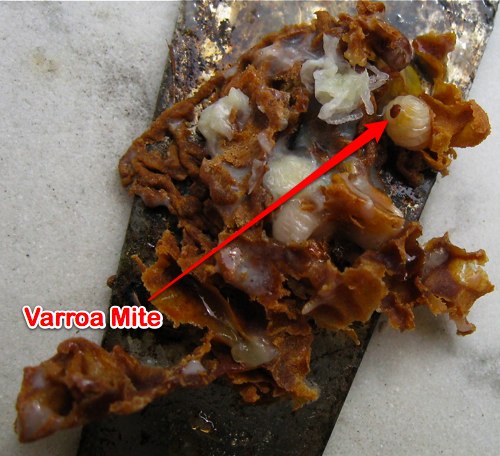
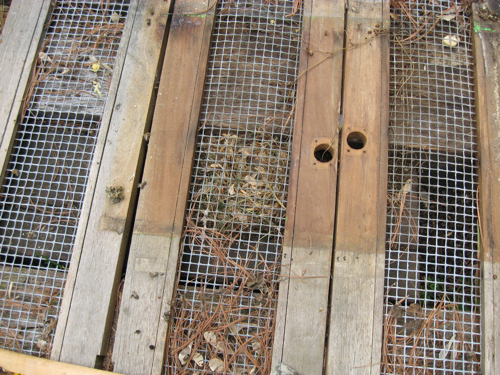

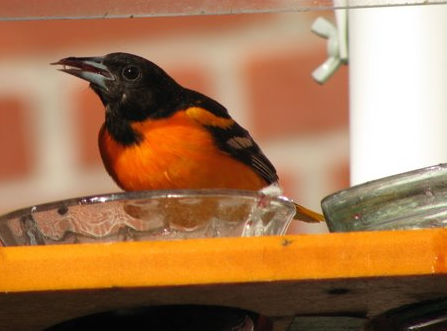 I've mentioned
I've mentioned 


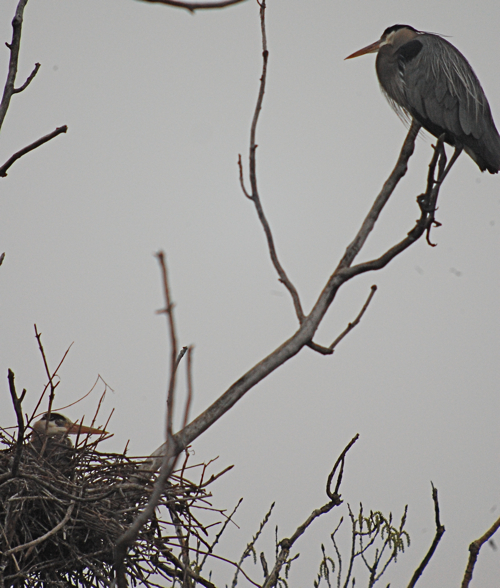 Providing that there is no major news breaking, the segment I recorded with
Providing that there is no major news breaking, the segment I recorded with  Last week I had to go to a meeting in Lake City, MN about the waterfowl surveys we did last fall, sort of going over the info collected and assessing what we might do different in the future. I headed down with Mark Martell and we took the scenic route to see what migrants might be lurking on the flooded river...we were not disappointed there was an awesome collection of ducks to be seen on the river. How many species can you pick out above?
Last week I had to go to a meeting in Lake City, MN about the waterfowl surveys we did last fall, sort of going over the info collected and assessing what we might do different in the future. I headed down with Mark Martell and we took the scenic route to see what migrants might be lurking on the flooded river...we were not disappointed there was an awesome collection of ducks to be seen on the river. How many species can you pick out above?











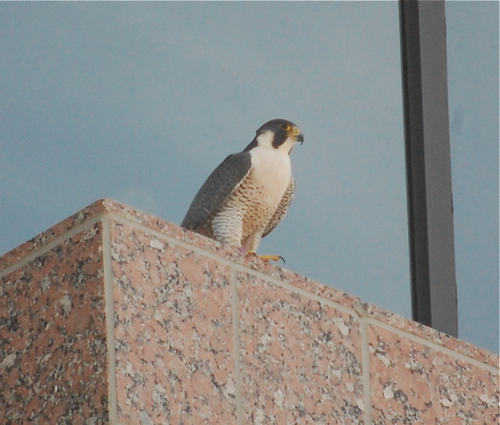 I was out at the
I was out at the